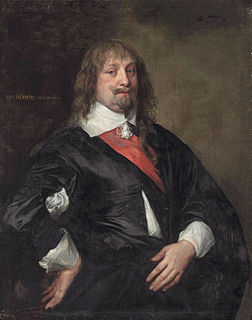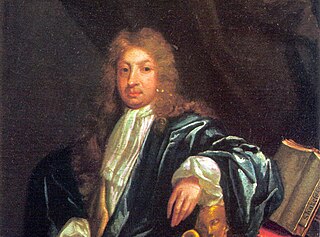This article presents lists of the literary events and publications in 1668.
This article presents lists of the literary events and publications in 1667.
This article presents lists of the literary events and publications in 1665.
This article presents lists of the literary events and publications in 1664.
This article presents lists of the literary events and publications in 1662.
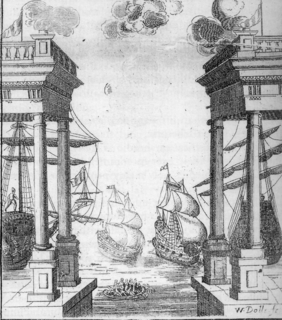
The Restoration spectacular, or elaborately staged machine play, hit the London public stage in the late 17th-century Restoration period, enthralling audiences with action, music, dance, moveable scenery, baroque illusionistic painting, gorgeous costumes, and special effects such as trapdoor tricks, "flying" actors, and fireworks. These shows have always had a bad reputation as a vulgar and commercial threat to the witty, "legitimate" Restoration drama; however, they drew Londoners in unprecedented numbers and left them dazzled and delighted.
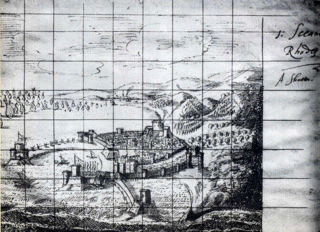
The Siege of Rhodes is an opera written to a text by the impresario William Davenant. The score is by five composers, the vocal music by Henry Lawes, Matthew Locke, and Captain Henry Cooke, and the instrumental music by Charles Coleman and George Hudson. It is considered to be the first English opera.
The patent theatres were the theatres that were licensed to perform "spoken drama" after the Restoration of Charles II as King of England, Scotland and Ireland in 1660. Other theatres were prohibited from performing such "serious" drama, but were permitted to show comedy, pantomime or melodrama. Drama was also interspersed with singing or dancing, to prevent the whole being too serious or dramatic.

The Dorset Garden Theatre in London, built in 1671, was in its early years also known as the Duke of York's Theatre, or the Duke's Theatre. In 1685, King Charles II died and his brother, the Duke of York, was crowned as James II. When the Duke became King, the theatre became the Queen's Theatre in 1685, referring to James' second wife, Mary of Modena. The name remained when William III and Mary II came to the throne in 1689.

Lisle's Tennis Court was a building off Portugal Street in Lincoln's Inn Fields in London. Originally built as a real tennis court, it was used as a playhouse during two periods, 1661–1674 and 1695–1705. During the early period, the theatre was called Lincoln's Inn Fields Playhouse, also known as The Duke's Playhouse, The New Theatre or The Opera. The building was demolished and replaced by a purpose-built theatre for a third period, 1714–1728. The tennis court theatre was the first public playhouse in London to feature the moveable scenery that would become a standard feature of Restoration theatres.

Victorian burlesque, sometimes known as travesty or extravaganza, is a genre of theatrical entertainment that was popular in Victorian England and in the New York theatre of the mid 19th century. It is a form of parody in which a well-known opera or piece of classical theatre or ballet is adapted into a broad comic play, usually a musical play, usually risqué in style, mocking the theatrical and musical conventions and styles of the original work, and often quoting or pastiching text or music from the original work. Victorian burlesque is one of several forms of burlesque.
Sir Martin Mar-all, or The Feign'd Innocence is an English Restoration comedy, first performed on 15 August 1667. Written by John Dryden and based on a translation of L'Étourdi by Molière, it was one of Dryden's earliest comedies, and also one of the greatest theatrical successes of his career.
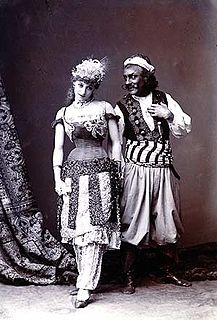
Robert Reece was a British comic playwright and librettist active in the Victorian era. He wrote many successful musical burlesques, comic operas, farces and adaptations from the French, including the English-language adaptation of the operetta Les cloches de Corneville, which became the longest-running piece of musical theatre in history up to that time. He sometimes collaborated with Henry Brougham Farnie or others.

The Duke's Company was a theatre company chartered by King Charles II at the start of the Restoration era, 1660. Sir William Davenant was manager of the company under Prince James, Duke of York's patronage. During this period, theatres began to flourish again after being closed due to restrictions throughout the Interregnum and English Civil War.
Claricilla is a Caroline era stage play, a tragicomedy written by Thomas Killigrew. The drama was acted c. 1636 by Queen Henrietta's Men at the Cockpit Theatre, and first published in 1641. The play was an early success that helped to confirm Killigrew's choice of artistic career.
The Cruelty of the Spaniards in Peru was an innovative 1658 theatrical presentation, a hybrid entertainment or masque or "operatic show", written and produced by Sir William Davenant. The music was composed by Matthew Locke.
Thomas Duffet, or Duffett, was an Irish playwright and songwriter active in England in the 1670s. He is remembered for his popular songs and his burlesques of the serious plays of John Dryden, Thomas Shadwell, Elkanah Settle, and Sir William Davenant.

The Mock Tempest, or the Enchanted Castle is a Restoration era stage play, a parody by Thomas Duffet; it premiered in 1674, and was first printed in 1675 by the bookseller William Cademan. In creating his farce, Duffet's target was not Shakespeare's famous play, but the adaptation of it that John Dryden and Sir William Davenant wrote in the 1660s. According to critic Michael West, "There are frequent nautical metaphors, and 'more noyse and terrour than a Tempest at Sea'...."


